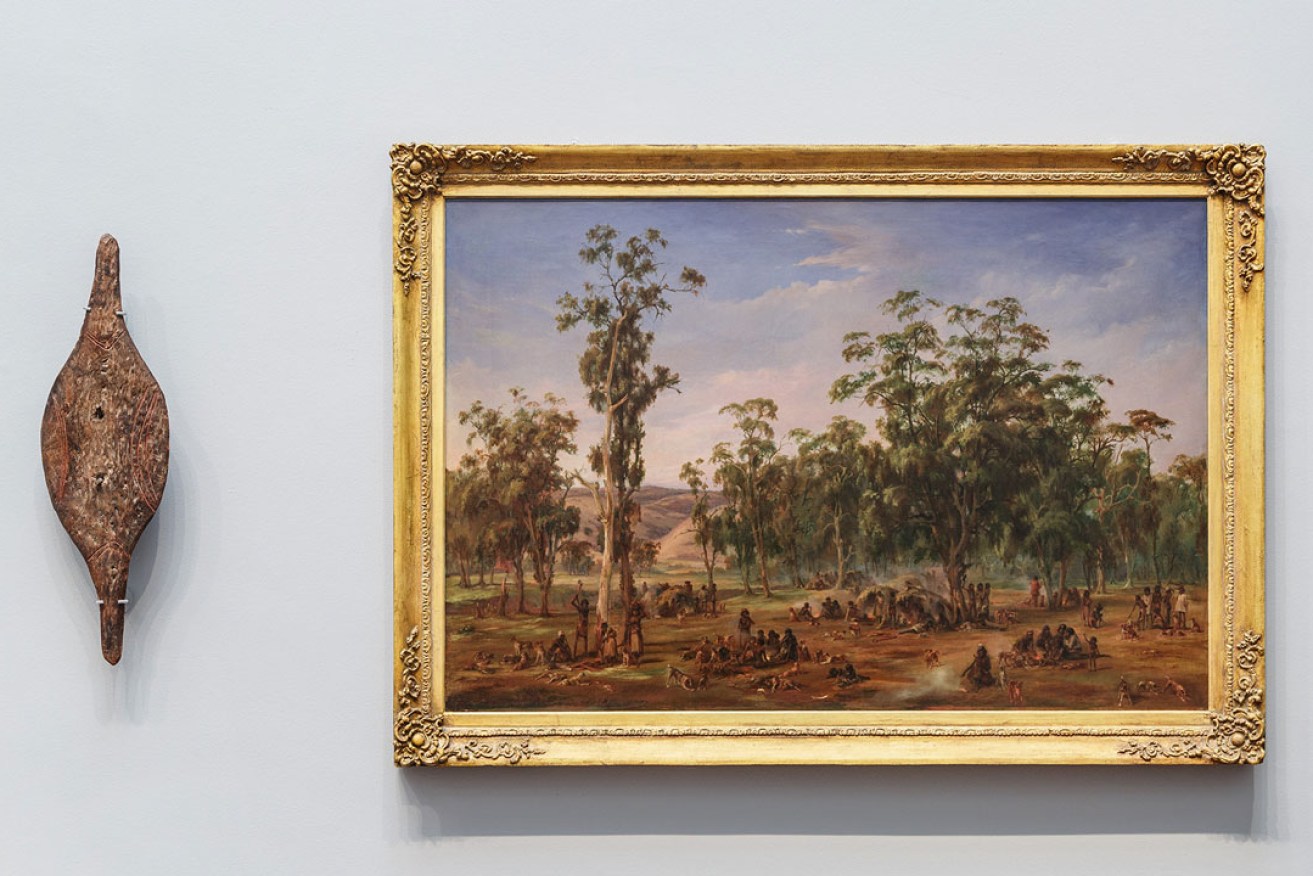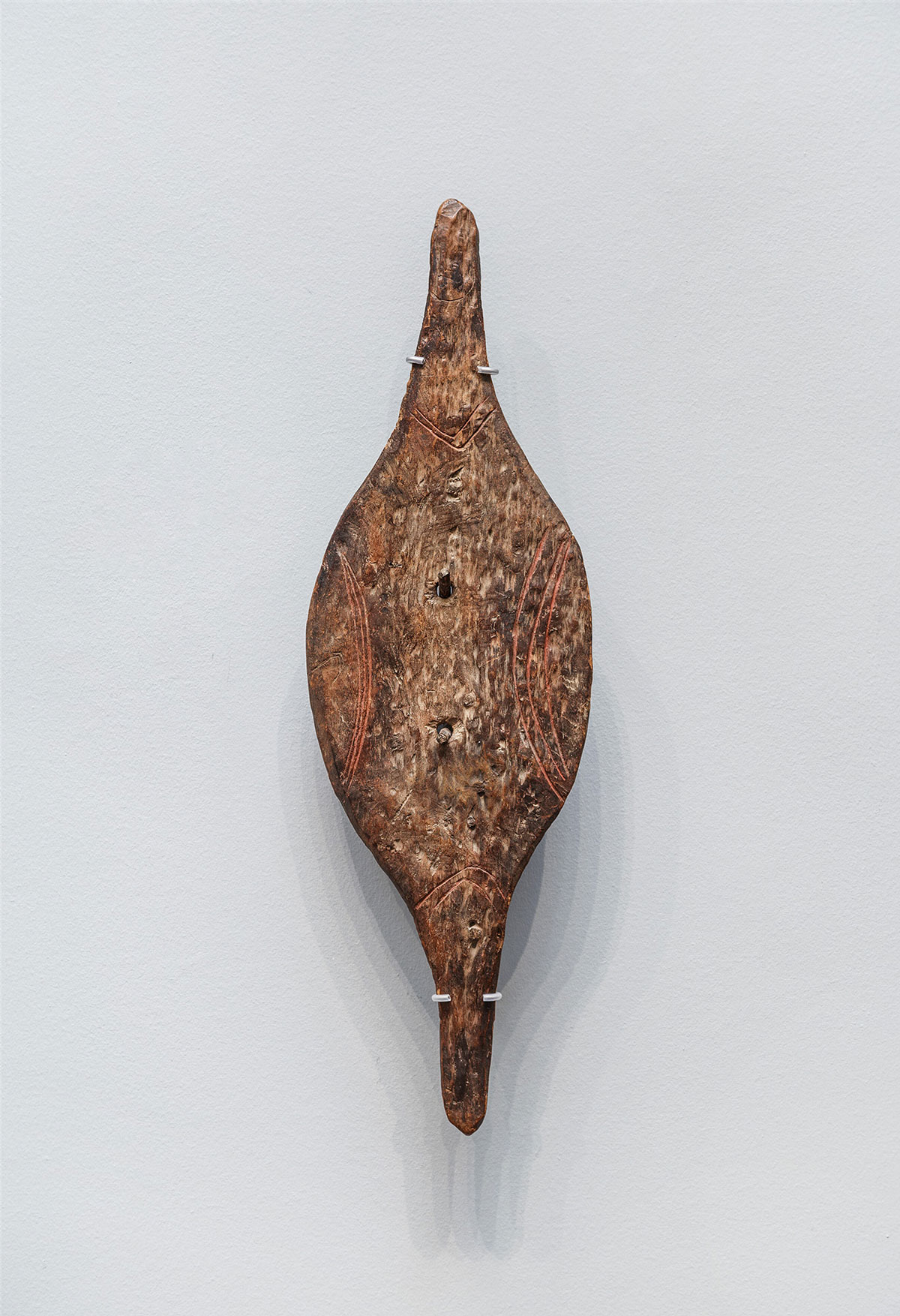Rare shield a reminder that you are on Kaurna Country
An extremely rare and culturally significant Kaurna shield on display in the Elder Wing of the Art Gallery of South Australia is imbued with many stories, write curators Nici Cumpston and Gloria Strzelecki.

The rare Murlapaka (shield) is displayed alongside Alexander Schramm's painting 'An Aboriginal encampment, near the Adelaide foothills'. Photo: Saul Steed
An extremely rare and culturally significant Kaurna shield has recently been acquired by the Art Gallery of South Australia after being uncovered in a private collection in Adelaide.
Called a Murlapaka by its owners – the Kaurna people of the Adelaide Plains – the broad shield is on permanent display in the gallery’s Elder Wing of Australian Art. It was acquired with support from the Federal Government through the National Cultural Heritage Account and following research by two respected scholars, Dr Jonathan Jones (Wiradjuri/Kamilaroi artist and curator) and Dr Carol Cooper (historian and curator).
Before acquiring the shield, AGSA invited senior Kaurna man Mickey Kumatpi Marrutya O’Brien to view the object. Here, he shares his thoughts and feelings upon viewing this important cultural object for the first time:

Murlapaka (shield), made by Kaurna people in the 19th century; Art Gallery of South Australia. Photo: Saul Steed
The Murlapaka Kaurna shield shows strength in its design, protection in its history, connection of country in its image, and the spirit of its creator in its life.
We know the land is the oldest living thing, the trees are connected to this land, the knowledge and wisdom of the land is in the trees.
The shield itself was cut from a tree and its shadow remained in the tree.
The shield took with it the knowledge and wisdom of the land, culture and people.
It returned to its home of the Kaurna Miyurna (Adelaide Plains People).
And now it tells many stories, when we listen, observe and share its journey and place…’
The Gallery’s Murlapaka is believed to be 150 to 200 years old, and may be even older.
There are only seven shields of its kind in collections across the globe and each is unique to its maker.
Kaurna people made and used two types of shields – the other is known as a Wocaltee, an example of which is held in the collection of the South Australian Museum. Murlapaka were used during ceremony as well as for protection during confrontation.
Cut from a eucalypt, possibly a Eucalyptus viminalis, the Murlapaka is characterised by its slender oval shape with elongated tapering tips. It is embellished with incised marks that run in opposing arc patterns along the outer edges and chevron shapes that point inwards at the base of each end.
Remnants of a red pigment can be seen within the incised markings in the gallery’s Murlapaka. Its handle has been made from a separate piece of wood that has been pushed through two holes in the centre while the wood was still pliable.
Currently the Murlapaka is on display alongside the colonial-era painting titled An Aboriginal encampment, near the Adelaide foothills, 1854, by German migrant artist Alexander Schramm.
Mickey Kumatpi Marrutya O’Brien has described the scene in Schramm’s painting as indicative of typical Kaurna life at the time – individual groups of family members are actively engaged with each other around fires to stay warm and cook food.
It’s interesting to think about where the shield would have been and who would have been owned it at this time. It’s even tempting to look for it in Schramm’s painting.
The presence of the Murlapaka at AGSA reminds everyone who enters the gallery that they are on Kaurna Country.
Nici Cumpston OAM is curator of Aboriginal and Torres Strait Islander Art at the AGSA and artistic director of the Tarnanthi Festival of Contemporary Aboriginal and Torres Strait Islander Art. Gloria Strzelecki is the gallery’s assistant curator of Aboriginal and Torres Strait Islander Art.




